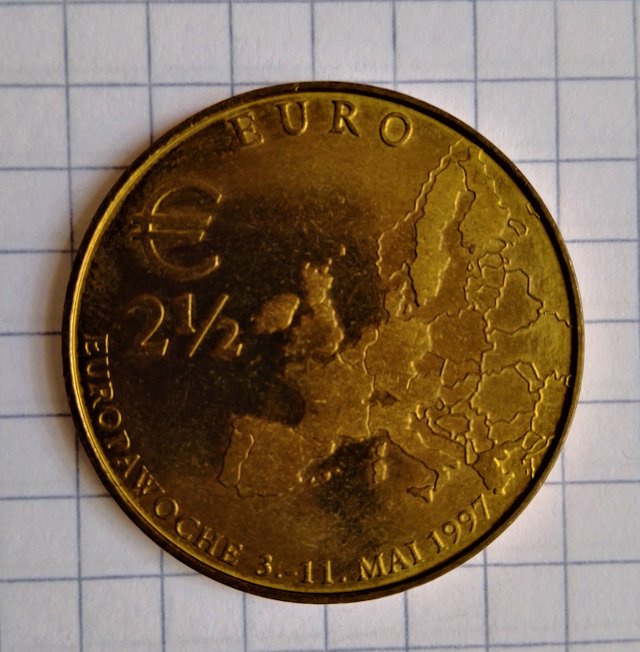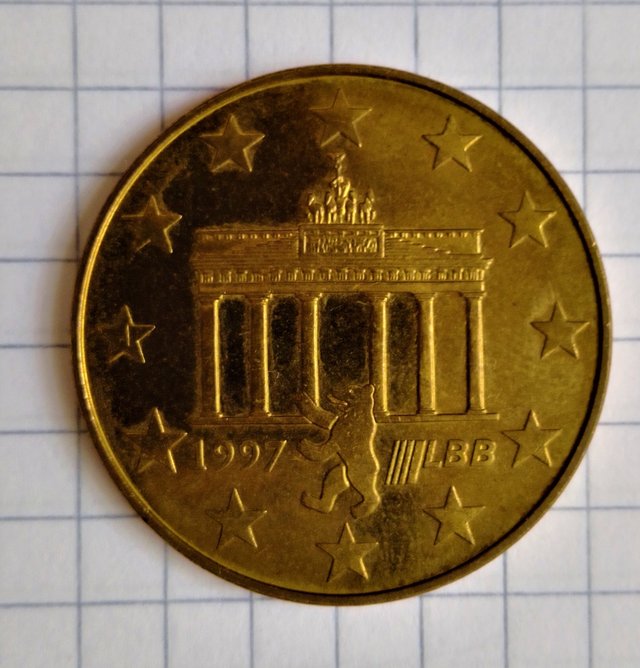Coin Collection #5 How Germany has promoted the Euro in the Federal Republic


Type Token
Year 1997
Value 2 1/2 Euro = 2 1/2 ECU (2.5)
Composition Copper plated steel
Weight 11.95 g
Diameter 31 mm
Shape Round
Orientation Medal alignment ↑↑
Commemorative issue
Europawoche May 1997 in Berlin
Obverse
Six-pillared gateway surrounded by 12 stars
Lettering: 1997 LBB
Reverse
Map of Europe
Lettering:
EURO
€
2½
EUROPAWOCHE 3.-11. MAI 1997
Edge
Smooth
The beginnings of the EU go back to the 1950s, when six states founded the European Economic Community (EEC). Targeted economic integration was intended to prevent military conflicts for the future and, through the larger market, to accelerate economic growth and thus increase the prosperity of citizens. Over the following decades, further states joined the Communities (EC) in several rounds of enlargement. From 1985, the Schengen Agreement opened the internal borders between the member states. After the fall of the Iron Curtain or the dissolution of the Eastern Bloc in 1989, the geopolitical situation in Europe changed fundamentally, creating opportunities to deepen integration, but also to prepare for enlargement in the East. In 1992, the Maastricht Treaty established the European Union, which thus acquired competences in non-economic policy areas. In several reform treaties, most recently the Treaty of Lisbon, the supranational competences of the EU were expanded and the democratic anchoring of political decision-making processes at Union level was improved, above all by further strengthening the position of the European Parliament. However, a European public sphere and identity as a prerequisite for supranational popular sovereignty is developing only gradually and not without countercurrents. Since the 1980s, the public debate on the constitution of the EU has also become more intense as the EU's competences have expanded and its significance has increased, and EU-sceptical positions have been increasingly articulated. In 2007, the Treaty of Lisbon also regulated exit scenarios.
Of the 27 EU states, 19 form an economic and monetary union. In 2002 a common currency was introduced for these countries, the euro.
In order to enforce this currency within the Federal Republic of Germany, something special has been devised for the capital. Under the motto "The euro is rolling in Berlin", "trial euros" specially minted by the "Landesbank" were issued to the value of 6.6 million German marks. The accompanying brochure, which was distributed en masse, also said that consumers had to prepare for monetary union and obtain information: "Up to now, this was only possible 'passively' with the help of information brochures. With Landesbank Berlin and the Euro Action Week, you can already experience the euro today and get 'active' information.
And that looked like this: At the branches of the Berliner Sparkasse or at one of the exchange booths set up, people exchanged Deutschmarks for practice euros, which were issued in a "crooked" denomination of 1.5, 2.5 and 10 euro coins, so that they would not later be confused with real euros; exchange rate: 1 euro = DM 2.
With these "Euros" now - the back of the medals sensibly shows the Brandenburg Gate - ma could shop in 52 shops on Tauentzienstraße, Kurfürstendamm, around Alexanderplatz and in the Nikolai Quarter. Learning effect: Only the coins, the numbers, the unit of account are different, the real value remains the same, you get the same for your money. A number of shops even advertised special offers that were only valid if you paid with euro money.
To anticipate the result: not even these special offers were noticed. At Ruhnke Optik, where euro-owners could choose from a wide range of sunglasses, the price difference was as high as 98 deutschmarks, and yet customers did not go across the street to exchange euros, preferring to pay in deutschmarks. Even at Café Kranzler on Ku'damm, hardly anyone wanted to pay with Euros; the saleswoman: "... but this morning an Italian tourist". The manager of McDonalds is also disappointed: "Nobody took advantage of the special euro offer. This has slowed down the business quite a bit, we had a special cash register filled only with Euros." The same picture everywhere: turnover in euros was extremely low or even zero. Apparently the gold, silver and copper medals were not bought to spend, but mainly as souvenirs or collectors' items. Good for the Landesbank! Of the 500,000 pieces whose sale she reported, not much more than the change that the shop owners had previously obtained should come
The Germans accepted the euro with great difficulty, but the new generations that were born again had fewer problems with it. Many German citizens at that time felt it was unfair that their wealth was halved and still cannot get used to it today. There are still enough Germans who are still angry: "That costs 2€! That would be 4 Marks back then!". Apparently they didn't take the changeover well. In the meantime, inflation has caught up with the numerical value in various products, which means that there are hardly any numerical differences. Historically, I personally don't think it's a stupid idea to align the currency within the EU economic area with that of its neighbours (Spanish pesetas were worth 1:1 like the Italian lira in the 1880s).
Thank you for reading, voting, sharing and espacially commenting
Sincerly